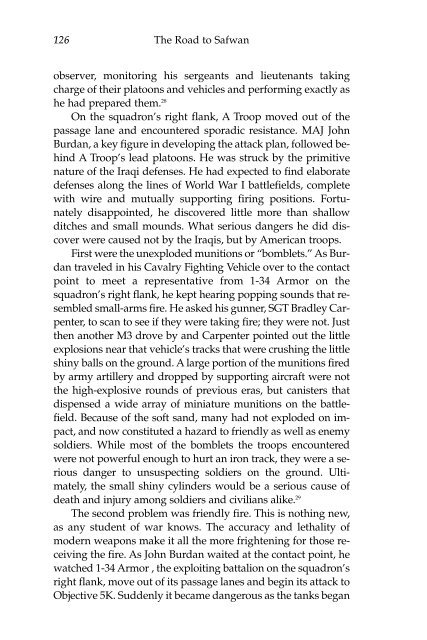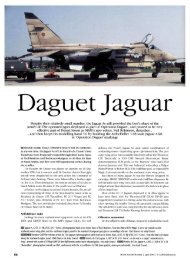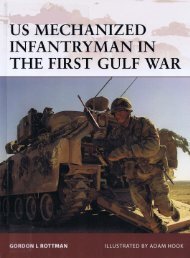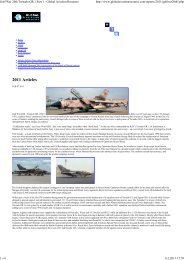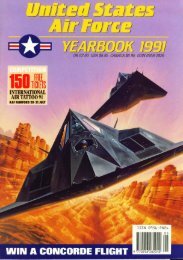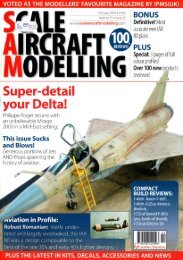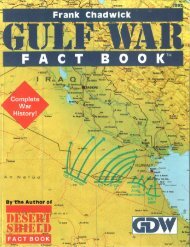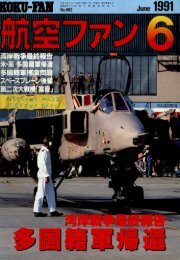The Road to Safwan: The 1st Squadron, 4th Cavalry in the 1991 ...
The Road to Safwan: The 1st Squadron, 4th Cavalry in the 1991 ...
The Road to Safwan: The 1st Squadron, 4th Cavalry in the 1991 ...
Create successful ePaper yourself
Turn your PDF publications into a flip-book with our unique Google optimized e-Paper software.
126 <strong>The</strong> <strong>Road</strong> <strong>to</strong> <strong>Safwan</strong><br />
observer, moni<strong>to</strong>r<strong>in</strong>g his sergeants and lieutenants tak<strong>in</strong>g<br />
charge of <strong>the</strong>ir pla<strong>to</strong>ons and vehicles and perform<strong>in</strong>g exactly as<br />
he had prepared <strong>the</strong>m. 28<br />
On <strong>the</strong> squadron’s right flank, A Troop moved out of <strong>the</strong><br />
passage lane and encountered sporadic resistance. MAJ John<br />
Burdan, a key figure <strong>in</strong> develop<strong>in</strong>g <strong>the</strong> attack plan, followed beh<strong>in</strong>d<br />
A Troop’s lead pla<strong>to</strong>ons. He was struck by <strong>the</strong> primitive<br />
nature of <strong>the</strong> Iraqi defenses. He had expected <strong>to</strong> f<strong>in</strong>d elaborate<br />
defenses along <strong>the</strong> l<strong>in</strong>es of World War I battlefields, complete<br />
with wire and mutually support<strong>in</strong>g fir<strong>in</strong>g positions. Fortunately<br />
disappo<strong>in</strong>ted, he discovered little more than shallow<br />
ditches and small mounds. What serious dangers he did discover<br />
were caused not by <strong>the</strong> Iraqis, but by American troops.<br />
First were <strong>the</strong> unexploded munitions or “bomblets.” As Burdan<br />
traveled <strong>in</strong> his <strong>Cavalry</strong> Fight<strong>in</strong>g Vehicle over <strong>to</strong> <strong>the</strong> contact<br />
po<strong>in</strong>t <strong>to</strong> meet a representative from 1-34 Armor on <strong>the</strong><br />
squadron’s right flank, he kept hear<strong>in</strong>g popp<strong>in</strong>g sounds that resembled<br />
small-arms fire. He asked his gunner, SGT Bradley Carpenter,<br />
<strong>to</strong> scan <strong>to</strong> see if <strong>the</strong>y were tak<strong>in</strong>g fire; <strong>the</strong>y were not. Just<br />
<strong>the</strong>n ano<strong>the</strong>r M3 drove by and Carpenter po<strong>in</strong>ted out <strong>the</strong> little<br />
explosions near that vehicle’s tracks that were crush<strong>in</strong>g <strong>the</strong> little<br />
sh<strong>in</strong>y balls on <strong>the</strong> ground. A large portion of <strong>the</strong> munitions fired<br />
by army artillery and dropped by support<strong>in</strong>g aircraft were not<br />
<strong>the</strong> high-explosive rounds of previous eras, but canisters that<br />
dispensed a wide array of m<strong>in</strong>iature munitions on <strong>the</strong> battlefield.<br />
Because of <strong>the</strong> soft sand, many had not exploded on impact,<br />
and now constituted a hazard <strong>to</strong> friendly as well as enemy<br />
soldiers. While most of <strong>the</strong> bomblets <strong>the</strong> troops encountered<br />
were not powerful enough <strong>to</strong> hurt an iron track, <strong>the</strong>y were a serious<br />
danger <strong>to</strong> unsuspect<strong>in</strong>g soldiers on <strong>the</strong> ground. Ultimately,<br />
<strong>the</strong> small sh<strong>in</strong>y cyl<strong>in</strong>ders would be a serious cause of<br />
death and <strong>in</strong>jury among soldiers and civilians alike. 29<br />
<strong>The</strong> second problem was friendly fire. This is noth<strong>in</strong>g new,<br />
as any student of war knows. <strong>The</strong> accuracy and lethality of<br />
modern weapons make it all <strong>the</strong> more frighten<strong>in</strong>g for those receiv<strong>in</strong>g<br />
<strong>the</strong> fire. As John Burdan waited at <strong>the</strong> contact po<strong>in</strong>t, he<br />
watched 1-34 Armor , <strong>the</strong> exploit<strong>in</strong>g battalion on <strong>the</strong> squadron’s<br />
right flank, move out of its passage lanes and beg<strong>in</strong> its attack <strong>to</strong><br />
Objective 5K. Suddenly it became dangerous as <strong>the</strong> tanks began


